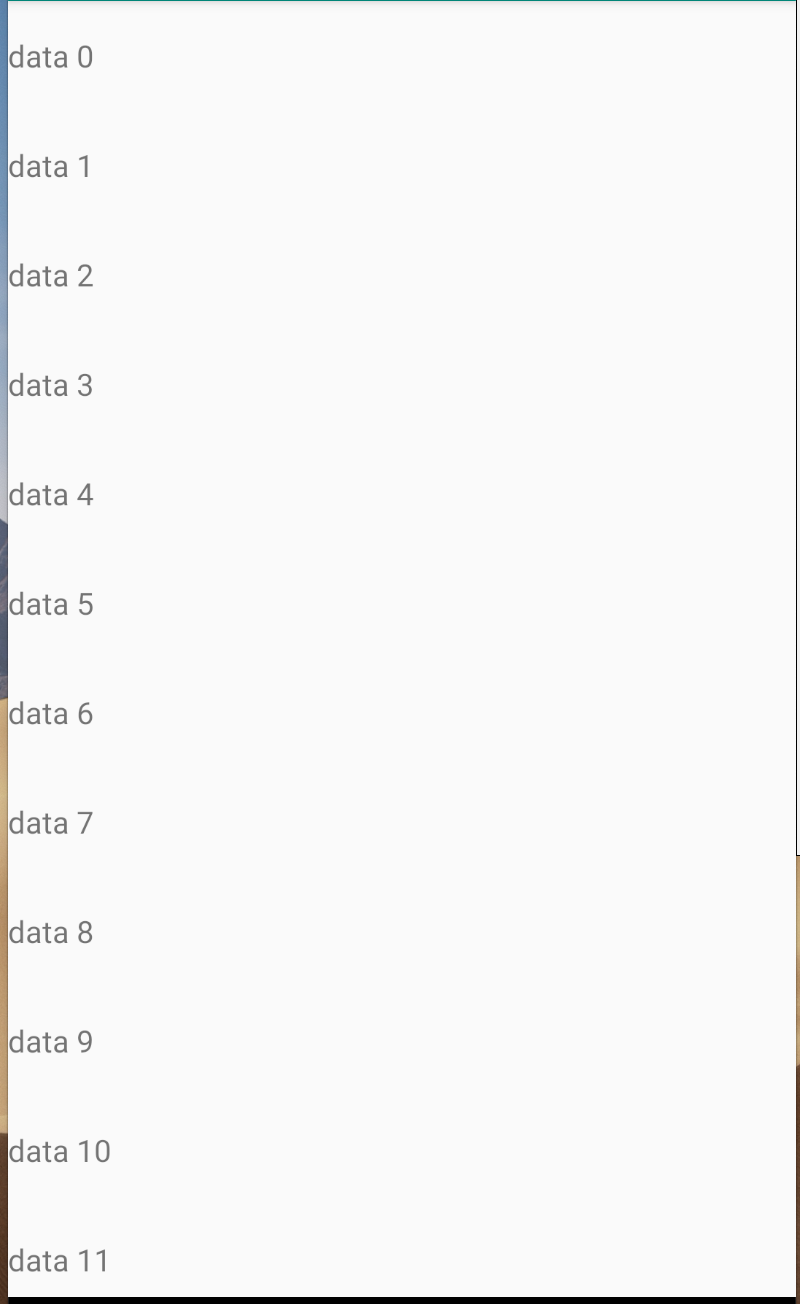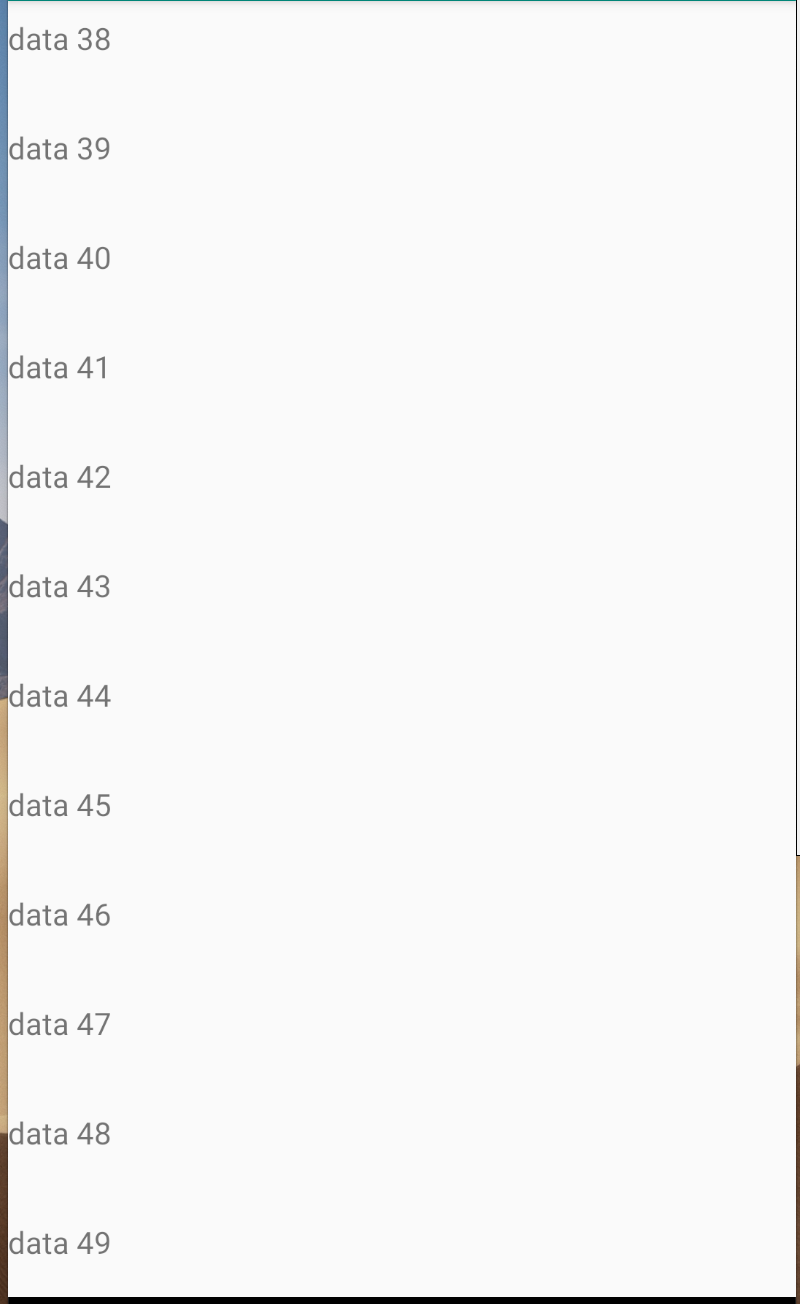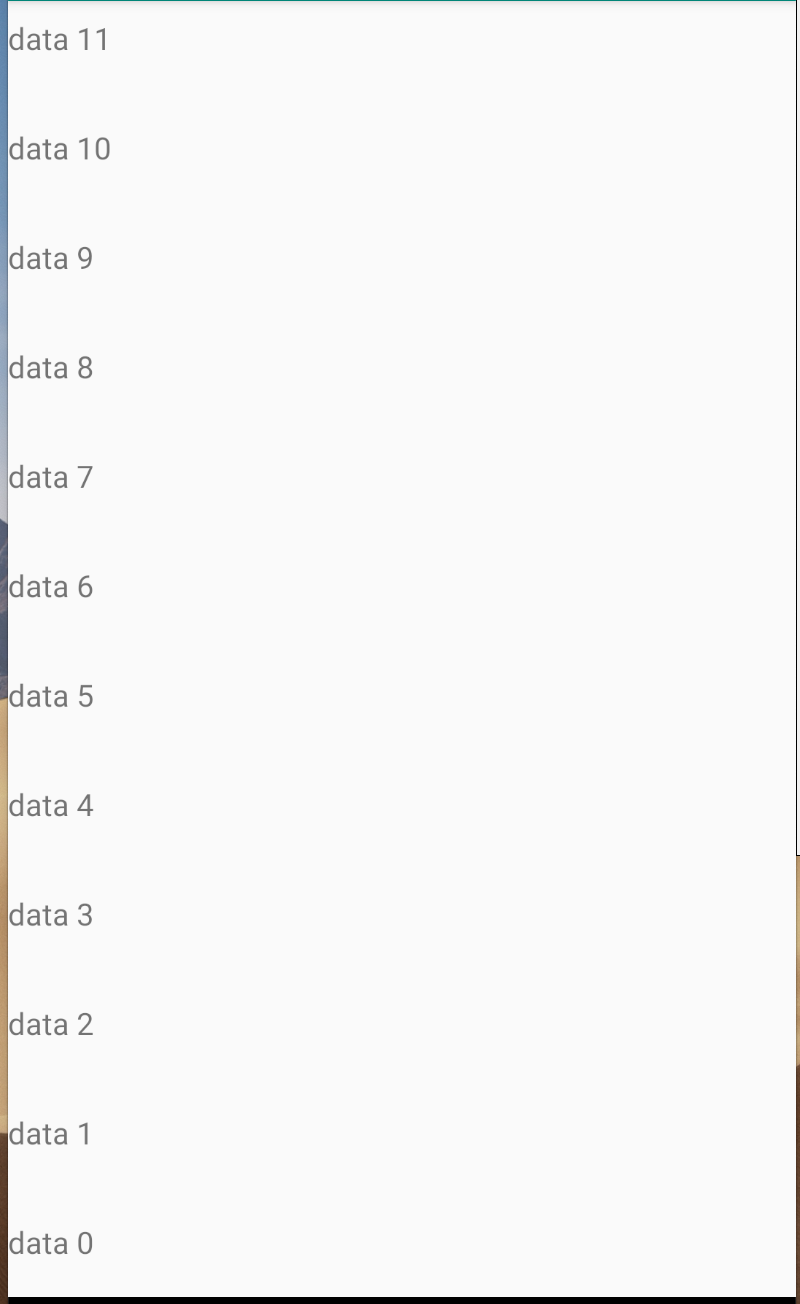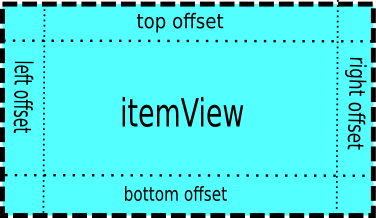Recyclerview 推出已经很久了,之前一直局限在使用上没有深入学习它的源码,本系列从源码上分析它的绘制流程、缓存机制、动画机制等。先看一下它的绘制流程。
onMeasure
@Override
protected void onMeasure(int widthSpec, int heightSpec) {
// 如果 LayoutManager 为 null 走 defaultOnMeasure
if (mLayout == null) {
defaultOnMeasure(widthSpec, heightSpec);
return;
}
//LayoutManager 是否支持自动测量
if (mLayout.isAutoMeasureEnabled()) {
final int widthMode = MeasureSpec.getMode(widthSpec);
final int heightMode = MeasureSpec.getMode(heightSpec);
/**
* This specific call should be considered deprecated and replaced with
* {@link #defaultOnMeasure(int, int)}. It can't actually be replaced as it could
* break existing third party code but all documentation directs developers to not
* override {@link LayoutManager#onMeasure(int, int)} when
* {@link LayoutManager#isAutoMeasureEnabled()} returns true.
*/
mLayout.onMeasure(mRecycler, mState, widthSpec, heightSpec);
final boolean measureSpecModeIsExactly =
widthMode == MeasureSpec.EXACTLY && heightMode == MeasureSpec.EXACTLY;
//如果是 EXACTLY 模式且 adapter 不为 null 返回
if (measureSpecModeIsExactly || mAdapter == null) {
return;
}
if (mState.mLayoutStep == State.STEP_START) {
dispatchLayoutStep1();
}
// set dimensions in 2nd step. Pre-layout should happen with old dimensions for
// consistency
mLayout.setMeasureSpecs(widthSpec, heightSpec);
mState.mIsMeasuring = true;
dispatchLayoutStep2();
// now we can get the width and height from the children.
mLayout.setMeasuredDimensionFromChildren(widthSpec, heightSpec);
// if RecyclerView has non-exact width and height and if there is at least one child
// which also has non-exact width & height, we have to re-measure.
if (mLayout.shouldMeasureTwice()) {
mLayout.setMeasureSpecs(
MeasureSpec.makeMeasureSpec(getMeasuredWidth(), MeasureSpec.EXACTLY),
MeasureSpec.makeMeasureSpec(getMeasuredHeight(), MeasureSpec.EXACTLY));
mState.mIsMeasuring = true;
dispatchLayoutStep2();
// now we can get the width and height from the children.
mLayout.setMeasuredDimensionFromChildren(widthSpec, heightSpec);
}
} else {
if (mHasFixedSize) {
mLayout.onMeasure(mRecycler, mState, widthSpec, heightSpec);
return;
}
// custom onMeasure
if (mAdapterUpdateDuringMeasure) {
startInterceptRequestLayout();
onEnterLayoutOrScroll();
processAdapterUpdatesAndSetAnimationFlags();
onExitLayoutOrScroll();
if (mState.mRunPredictiveAnimations) {
mState.mInPreLayout = true;
} else {
// consume remaining updates to provide a consistent state with the layout pass.
mAdapterHelper.consumeUpdatesInOnePass();
mState.mInPreLayout = false;
}
mAdapterUpdateDuringMeasure = false;
stopInterceptRequestLayout(false);
} else if (mState.mRunPredictiveAnimations) {
// If mAdapterUpdateDuringMeasure is false and mRunPredictiveAnimations is true:
// this means there is already an onMeasure() call performed to handle the pending
// adapter change, two onMeasure() calls can happen if RV is a child of LinearLayout
// with layout_width=MATCH_PARENT. RV cannot call LM.onMeasure() second time
// because getViewForPosition() will crash when LM uses a child to measure.
setMeasuredDimension(getMeasuredWidth(), getMeasuredHeight());
return;
}
if (mAdapter != null) {
mState.mItemCount = mAdapter.getItemCount();
} else {
mState.mItemCount = 0;
}
startInterceptRequestLayout();
mLayout.onMeasure(mRecycler, mState, widthSpec, heightSpec);
stopInterceptRequestLayout(false);
mState.mInPreLayout = false; // clear
}
}
onMeasure 的全部源码如上,下面我们一步步分析下它:
if (mLayout == null) {
defaultOnMeasure(widthSpec, heightSpec);
return;
}
首先是没有设置 LayoutManager 的情况,在开发中我们可能遇到过这种情况,忘了设置 LayoutManager。此时:
- 页面一片空白
- log 中输出一下提示:E/RecyclerView: No layout manager attached; skipping layout
我们继续,看一下 defaultOnMeasure:
void defaultOnMeasure(int widthSpec, int heightSpec) {
final int width = LayoutManager.chooseSize(widthSpec,
getPaddingLeft() + getPaddingRight(),
ViewCompat.getMinimumWidth(this));
final int height = LayoutManager.chooseSize(heightSpec,
getPaddingTop() + getPaddingBottom(),
ViewCompat.getMinimumHeight(this));
setMeasuredDimension(width, height);
}
其实如果 LayoutManager 测量模式为 auto,走的也是 defaultOnMeasure,这里通过 LayoutManager 的 chooseSize 为 RecyclerView 计算出合适的尺寸。
RecyclerView#LayoutManager#chooseSize
public static int chooseSize(int spec, int desired, int min) {
final int mode = View.MeasureSpec.getMode(spec);
final int size = View.MeasureSpec.getSize(spec);
switch (mode) {
case View.MeasureSpec.EXACTLY:
return size;
case View.MeasureSpec.AT_MOST:
return Math.min(size, Math.max(desired, min));
case View.MeasureSpec.UNSPECIFIED:
default:
return Math.max(desired, min);
}
}
继续回到 onMeasure,接下来是一个判断:
if (mLayout.isAutoMeasureEnabled())
目前官方提供的三个 LayoutManager 的 mAutoMeasure 都是 true。在这里:
- 如果 mAutoMeasure 为真,走 defaultOnMeasure 。
- 如果 mAutoMeasure 为假,走 LayoutManager 的 onMeasure。
mAutoMeasure 不为真的情况我们我们就不分析了,这种需要在自定义 LayoutManager 的时候根据情况复写自定义 LayoutManager 的 onMeasure。
接着再往下,我们发现它还是走的
/**
* This specific call should be considered deprecated and replaced with
* {@link #defaultOnMeasure(int, int)}. It can't actually be replaced as it could
* break existing third party code but all documentation directs developers to not
* override {@link LayoutManager#onMeasure(int, int)} when
* {@link LayoutManager#isAutoMeasureEnabled()} returns true.
*/
mLayout.onMeasure(mRecycler, mState, widthSpec, heightSpec);
不过它有一段注释,大意是:
这种写法应该被废弃,只是为了兼容一些第三方的代码才这样写。如果 isAutoMeasureEnabled() 返回 true ,请不要复写 LayoutManager 的 onMeasure。
继续往下:
final boolean measureSpecModeIsExactly =
widthMode == MeasureSpec.EXACTLY && heightMode == MeasureSpec.EXACTLY;
if (measureSpecModeIsExactly || mAdapter == null) {
return;
}
如果测量模式是 EXACTLY 直接返回,测量模式是 EXACTLY 的情况下,控件可以得到它想要的 size,这时候不必继续测量下去,返回进行布局。
继续:
if (mState.mLayoutStep == State.STEP_START) {
dispatchLayoutStep1();
}
// set dimensions in 2nd step. Pre-layout should happen with old dimensions for
// consistency
mLayout.setMeasureSpecs(widthSpec, heightSpec);
mState.mIsMeasuring = true;
dispatchLayoutStep2();
// now we can get the width and height from the children.
mLayout.setMeasuredDimensionFromChildren(widthSpec, heightSpec);
dispatchLayoutStep1() 主要进行一些动画的准备,这不是我们今天的重点,先跳过,在分析动画的时候再分析。 dispatchLayoutStep2() 是主要的布局阶段,我们详细看一下它:
/**
* The second layout step where we do the actual layout of the views for the final state.
* This step might be run multiple times if necessary (e.g. measure).
*/
private void dispatchLayoutStep2() {
//禁止子 View 的 requestLayout() 操作。
startInterceptRequestLayout();
onEnterLayoutOrScroll();
mState.assertLayoutStep(State.STEP_LAYOUT | State.STEP_ANIMATIONS);
mAdapterHelper.consumeUpdatesInOnePass();
//获取 item 数量
mState.mItemCount = mAdapter.getItemCount();
mState.mDeletedInvisibleItemCountSincePreviousLayout = 0;
// Step 2: Run layout
mState.mInPreLayout = false;
//调用 layoutManager 布局 children
mLayout.onLayoutChildren(mRecycler, mState);
mState.mStructureChanged = false;
mPendingSavedState = null;
// onLayoutChildren may have caused client code to disable item animations; re-check
mState.mRunSimpleAnimations = mState.mRunSimpleAnimations && mItemAnimator != null;
mState.mLayoutStep = State.STEP_ANIMATIONS;
onExitLayoutOrScroll();
stopInterceptRequestLayout(false);
}
真正的布局 children 是调用的 LayoutManager 的 onLayoutChildren,这也是为什么不同的 LayoutManager 可以有不同的布局效果。 这里我们进入 LayoutManager 看一下(本文分析的是 LinearLayoutManager)。
LinearLayoutManager#onLayoutChildren
public void onLayoutChildren(RecyclerView.Recycler recycler, RecyclerView.State state) {
// layout algorithm:
// 布局算法
// 1) by checking children and other variables, find an anchor coordinate and an anchor
// item position.
// 1) 寻找锚点
// 2) fill towards start, stacking from bottom
// 2) 向上填充
// 3) fill towards end, stacking from top
// 3) 向下填充
// 4) scroll to fulfill requirements like stack from bottom.
// create layout state
...
// resolve layout direction
// 判断绘制方向
resolveShouldLayoutReverse();
final View focused = getFocusedChild();
//mValid的默认值是false,一次测量之后设为true,onLayout完成后会回调执行reset方法,又变为false
if (!mAnchorInfo.mValid || mPendingScrollPosition != RecyclerView.NO_POSITION
|| mPendingSavedState != null) {
mAnchorInfo.reset();
// 判断绘制方向
mAnchorInfo.mLayoutFromEnd = mShouldReverseLayout ^ mStackFromEnd;
// calculate anchor position and coordinate
updateAnchorInfoForLayout(recycler, state, mAnchorInfo);
mAnchorInfo.mValid = true;
} else if (focused != null && (mOrientationHelper.getDecoratedStart(focused)
>= mOrientationHelper.getEndAfterPadding()
|| mOrientationHelper.getDecoratedEnd(focused)
<= mOrientationHelper.getStartAfterPadding())) {
...
}
...
onAnchorReady(recycler, state, mAnchorInfo, firstLayoutDirection);
detachAndScrapAttachedViews(recycler);
mLayoutState.mInfinite = resolveIsInfinite();
mLayoutState.mIsPreLayout = state.isPreLayout();
if (mAnchorInfo.mLayoutFromEnd) {
// 根据布局方向等更新 LayoutState
updateLayoutStateToFillStart(mAnchorInfo);
mLayoutState.mExtra = extraForStart;
// 布局 item
fill(recycler, mLayoutState, state, false);
startOffset = mLayoutState.mOffset;
final int firstElement = mLayoutState.mCurrentPosition;
if (mLayoutState.mAvailable > 0) {
extraForEnd += mLayoutState.mAvailable;
}
// 根据布局方向等更新 LayoutState
updateLayoutStateToFillEnd(mAnchorInfo);
mLayoutState.mExtra = extraForEnd;
mLayoutState.mCurrentPosition += mLayoutState.mItemDirection;
// 布局 item
fill(recycler, mLayoutState, state, false);
endOffset = mLayoutState.mOffset;
...
} else {
// 根据布局方向等更新 LayoutState
updateLayoutStateToFillEnd(mAnchorInfo);
mLayoutState.mExtra = extraForEnd;
// 布局item
fill(recycler, mLayoutState, state, false);
endOffset = mLayoutState.mOffset;
final int lastElement = mLayoutState.mCurrentPosition;
if (mLayoutState.mAvailable > 0) {
extraForStart += mLayoutState.mAvailable;
}
// 根据布局方向等更新 LayoutState
updateLayoutStateToFillStart(mAnchorInfo);
mLayoutState.mExtra = extraForStart;
mLayoutState.mCurrentPosition += mLayoutState.mItemDirection;
// 布局 item
fill(recycler, mLayoutState, state, false);
startOffset = mLayoutState.mOffset;
...
}
...
layoutForPredictiveAnimations(recycler, state, startOffset, endOffset);
if (!state.isPreLayout()) {
mOrientationHelper.onLayoutComplete();
} else {
mAnchorInfo.reset();
}
mLastStackFromEnd = mStackFromEnd;
if (DEBUG) {
validateChildOrder();
}
}
以上是 onLayoutChildren 的代码,它主要分为三个步骤:
-
- 寻找锚点
-
- 根据锚点和绘制方向更新 LayoutState
-
- 布局 item
接下来一步步看源码:
寻找锚点
// 判断绘制方向
resolveShouldLayoutReverse();
final View focused = getFocusedChild();
//mValid的默认值是false,一次测量之后设为true,onLayout完成后会回调执行reset方法,又变为false
if (!mAnchorInfo.mValid || mPendingScrollPosition != RecyclerView.NO_POSITION
|| mPendingSavedState != null) {
mAnchorInfo.reset();
// 判断绘制方向
mAnchorInfo.mLayoutFromEnd = mShouldReverseLayout ^ mStackFromEnd;
// calculate anchor position and coordinate
updateAnchorInfoForLayout(recycler, state, mAnchorInfo);
mAnchorInfo.mValid = true;
} else if (focused != null && (mOrientationHelper.getDecoratedStart(focused)
>= mOrientationHelper.getEndAfterPadding()
|| mOrientationHelper.getDecoratedEnd(focused)
<= mOrientationHelper.getStartAfterPadding())) {
...
}
判断绘制方向的时候有一个异或运算:
mAnchorInfo.mLayoutFromEnd = mShouldReverseLayout ^ mStackFromEnd;
mReverseLayout 和 mStackFromEnd 这两个参数要说明一下:
- mStackFromEnd 不改变 item 方向,但是从尾部开始显示。
- mReverseLayout 改变元素显示顺序
一下分别是正常情况,设置 mStackFromEnd 为 true 和 mReverseLayout 为 true 的效果。



接下来就是锚点信息的确定,比较复杂,这里就不分析了,接下来就是 item 的布局:
{
updateLayoutStateToFillStart(mAnchorInfo);
mLayoutState.mExtra = extraForStart;
fill(recycler, mLayoutState, state, false);
startOffset = mLayoutState.mOffset;
final int firstElement = mLayoutState.mCurrentPosition;
if (mLayoutState.mAvailable > 0) {
extraForEnd += mLayoutState.mAvailable;
}
updateLayoutStateToFillEnd(mAnchorInfo);
mLayoutState.mExtra = extraForEnd;
mLayoutState.mCurrentPosition += mLayoutState.mItemDirection;
fill(recycler, mLayoutState, state, false);
endOffset = mLayoutState.mOffset;
if (mLayoutState.mAvailable > 0) {
// end could not consume all. add more items towards start
extraForStart = mLayoutState.mAvailable;
updateLayoutStateToFillStart(firstElement, startOffset);
mLayoutState.mExtra = extraForStart;
fill(recycler, mLayoutState, state, false);
startOffset = mLayoutState.mOffset;
}
}
主要有两个步骤:
- 1、 updateLayoutStateToFillStart(mAnchorInfo); 更新 LayoutState 信息
- 2、 fill(recycler, mLayoutState, state, false); 布局 item。 可以看到至少会调用两次 fill 当有剩余空间的时候还会在调用一次。我们来看下它:
int fill(RecyclerView.Recycler recycler, LayoutState layoutState,
RecyclerView.State state, boolean stopOnFocusable) {
...
while ((layoutState.mInfinite || remainingSpace > 0) && layoutState.hasMore(state)) {
...
layoutChunk(recycler, state, layoutState, layoutChunkResult);
...
}
return start - layoutState.mAvailable;
}
这个方法的注释是:
The magic functions :). Fills the given layout, defined by the layoutState. This is fairly independent from the rest of the {@link LinearLayoutManager} and with little change, can be made publicly available as a helper class.
简单翻译一下:
魔法函数,根据 layoutstate 填充指定的 layout。这个函数完全独立于 LinearLayoutManager,只需要很小的改变它就能成为一个公共的帮助类。
fill 里又调用了 layoutChunk:
void layoutChunk(RecyclerView.Recycler recycler, RecyclerView.State state,
LayoutState layoutState, LayoutChunkResult result) {
View view = layoutState.next(recycler);
if (view == null) {
if (DEBUG && layoutState.mScrapList == null) {
throw new RuntimeException("received null view when unexpected");
}
// if we are laying out views in scrap, this may return null which means there is
// no more items to layout.
result.mFinished = true;
return;
}
RecyclerView.LayoutParams params = (RecyclerView.LayoutParams) view.getLayoutParams();
if (layoutState.mScrapList == null) {
if (mShouldReverseLayout == (layoutState.mLayoutDirection
== LayoutState.LAYOUT_START)) {
addView(view);
} else {
addView(view, 0);
}
} else {
if (mShouldReverseLayout == (layoutState.mLayoutDirection
== LayoutState.LAYOUT_START)) {
addDisappearingView(view);
} else {
addDisappearingView(view, 0);
}
}
measureChildWithMargins(view, 0, 0);
result.mConsumed = mOrientationHelper.getDecoratedMeasurement(view);
int left, top, right, bottom;
if (mOrientation == VERTICAL) {
if (isLayoutRTL()) {
right = getWidth() - getPaddingRight();
left = right - mOrientationHelper.getDecoratedMeasurementInOther(view);
} else {
left = getPaddingLeft();
right = left + mOrientationHelper.getDecoratedMeasurementInOther(view);
}
if (layoutState.mLayoutDirection == LayoutState.LAYOUT_START) {
bottom = layoutState.mOffset;
top = layoutState.mOffset - result.mConsumed;
} else {
top = layoutState.mOffset;
bottom = layoutState.mOffset + result.mConsumed;
}
} else {
top = getPaddingTop();
bottom = top + mOrientationHelper.getDecoratedMeasurementInOther(view);
if (layoutState.mLayoutDirection == LayoutState.LAYOUT_START) {
right = layoutState.mOffset;
left = layoutState.mOffset - result.mConsumed;
} else {
left = layoutState.mOffset;
right = layoutState.mOffset + result.mConsumed;
}
}
// We calculate everything with View's bounding box (which includes decor and margins)
// To calculate correct layout position, we subtract margins.
layoutDecoratedWithMargins(view, left, top, right, bottom);
if (DEBUG) {
Log.d(TAG, "laid out child at position " + getPosition(view) + ", with l:"
+ (left + params.leftMargin) + ", t:" + (top + params.topMargin) + ", r:"
+ (right - params.rightMargin) + ", b:" + (bottom - params.bottomMargin));
}
// Consume the available space if the view is not removed OR changed
if (params.isItemRemoved() || params.isItemChanged()) {
result.mIgnoreConsumed = true;
}
result.mFocusable = view.hasFocusable();
}
layoutChunk 主要做三件事:
- View view = layoutState.next(recycler); 获取 itemView。
- measureChildWithMargins(view, 0, 0); measure child view。
- layoutDecoratedWithMargins(view, left, top, right, bottom);布局装饰后的 itemView。
首先我们看 LayoutState.next:
View next(RecyclerView.Recycler recycler) {
if (mScrapList != null) {
return nextViewFromScrapList();
}
final View view = recycler.getViewForPosition(mCurrentPosition);
mCurrentPosition += mItemDirection;
return view;
}
Recycler#getViewForPosition
@NonNull
public View getViewForPosition(int position) {
return getViewForPosition(position, false);
}
View getViewForPosition(int position, boolean dryRun) {
return tryGetViewHolderForPositionByDeadline(position, dryRun, FOREVER_NS).itemView;
}
最终是从 tryGetViewHolderForPositionByDeadline 获取 itemView,这个方法代码量有点多,我们分析 Recycler 缓存的时候再去分析它。
继续回到 layoutChunk 拿到 view 之后是 addView,再之后是 measureChildWithMargins:
public void measureChildWithMargins(@NonNull View child, int widthUsed, int heightUsed) {
final LayoutParams lp = (LayoutParams) child.getLayoutParams();
final Rect insets = mRecyclerView.getItemDecorInsetsForChild(child);
widthUsed += insets.left + insets.right;
heightUsed += insets.top + insets.bottom;
final int widthSpec = getChildMeasureSpec(getWidth(), getWidthMode(),
getPaddingLeft() + getPaddingRight()
+ lp.leftMargin + lp.rightMargin + widthUsed, lp.width,
canScrollHorizontally());
final int heightSpec = getChildMeasureSpec(getHeight(), getHeightMode(),
getPaddingTop() + getPaddingBottom()
+ lp.topMargin + lp.bottomMargin + heightUsed, lp.height,
canScrollVertically());
if (shouldMeasureChild(child, widthSpec, heightSpec, lp)) {
child.measure(widthSpec, heightSpec);
}
}
这个方法里我们看到了子 View 的测量,这里有一个要注意的地方:getItemDecorInsetsForChild
Rect getItemDecorInsetsForChild(View child) {
final LayoutParams lp = (LayoutParams) child.getLayoutParams();
if (!lp.mInsetsDirty) {
return lp.mDecorInsets;
}
if (mState.isPreLayout() && (lp.isItemChanged() || lp.isViewInvalid())) {
// changed/invalid items should not be updated until they are rebound.
return lp.mDecorInsets;
}
final Rect insets = lp.mDecorInsets;
insets.set(0, 0, 0, 0);
final int decorCount = mItemDecorations.size();
for (int i = 0; i < decorCount; i++) {
mTempRect.set(0, 0, 0, 0);
mItemDecorations.get(i).getItemOffsets(mTempRect, child, this, mState);
insets.left += mTempRect.left;
insets.top += mTempRect.top;
insets.right += mTempRect.right;
insets.bottom += mTempRect.bottom;
}
lp.mInsetsDirty = false;
return insets;
}
这里其实是在测量 view 的时候加上,ItemDecoration 时设置的边距。

测量之后紧接着就走了 layoutDecoratedWithMargins 完成了 itemView 的布局。
到这里 onMeasure 基本上就讲完了。 还有两个问题:
- 为什么在 onMeasure 里进行布局。
- 测量模式不是 EXACTLY 的情况下,RecyclerView 什么时候完成自己 size 的测量。
我们再回到 onMeasure,dispatchLayoutStep2() 之后有这么一行:
// now we can get the width and height from the children.
mLayout.setMeasuredDimensionFromChildren(widthSpec, heightSpec);
void setMeasuredDimensionFromChildren(int widthSpec, int heightSpec) {
final int count = getChildCount();
if (count == 0) {
mRecyclerView.defaultOnMeasure(widthSpec, heightSpec);
return;
}
int minX = Integer.MAX_VALUE;
int minY = Integer.MAX_VALUE;
int maxX = Integer.MIN_VALUE;
int maxY = Integer.MIN_VALUE;
for (int i = 0; i < count; i++) {
View child = getChildAt(i);
final Rect bounds = mRecyclerView.mTempRect;
getDecoratedBoundsWithMargins(child, bounds);
if (bounds.left < minX) {
minX = bounds.left;
}
if (bounds.right > maxX) {
maxX = bounds.right;
}
if (bounds.top < minY) {
minY = bounds.top;
}
if (bounds.bottom > maxY) {
maxY = bounds.bottom;
}
}
mRecyclerView.mTempRect.set(minX, minY, maxX, maxY);
setMeasuredDimension(mRecyclerView.mTempRect, widthSpec, heightSpec);
}
在测量模式不是 EXACTLY 直接用 ItemView 填充可用空间,在填充完之后再根据 ItemView 占用的空间设置 MeasuredDimension。
onMeasure 分析完了,我们看下 onLayout。
onLayout
@Override
protected void onLayout(boolean changed, int l, int t, int r, int b) {
TraceCompat.beginSection(TRACE_ON_LAYOUT_TAG);
dispatchLayout();
TraceCompat.endSection();
mFirstLayoutComplete = true;
}
void dispatchLayout() {
if (mAdapter == null) {
Log.e(TAG, "No adapter attached; skipping layout");
// leave the state in START
return;
}
if (mLayout == null) {
Log.e(TAG, "No layout manager attached; skipping layout");
// leave the state in START
return;
}
mState.mIsMeasuring = false;
if (mState.mLayoutStep == State.STEP_START) {
dispatchLayoutStep1();
mLayout.setExactMeasureSpecsFrom(this);
dispatchLayoutStep2();
} else if (mAdapterHelper.hasUpdates() || mLayout.getWidth() != getWidth()
|| mLayout.getHeight() != getHeight()) {
// First 2 steps are done in onMeasure but looks like we have to run again due to
// changed size.
mLayout.setExactMeasureSpecsFrom(this);
dispatchLayoutStep2();
} else {
// always make sure we sync them (to ensure mode is exact)
mLayout.setExactMeasureSpecsFrom(this);
}
dispatchLayoutStep3();
}
结合上面的 onMeasure ,如果测量模式为 Exactly ,这里 State step 为 STEP_START 仍然会进行 dispatchLayoutStep1 和 dispatchLayoutStep2。